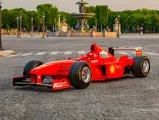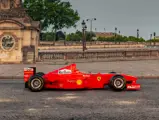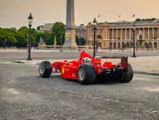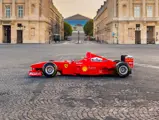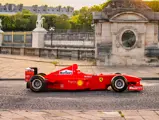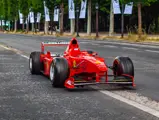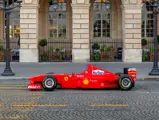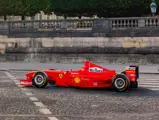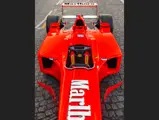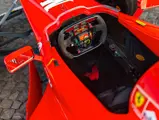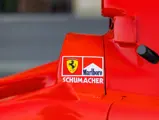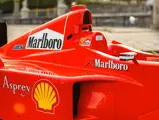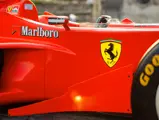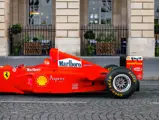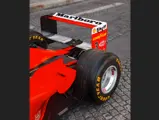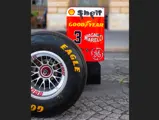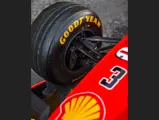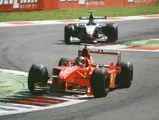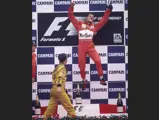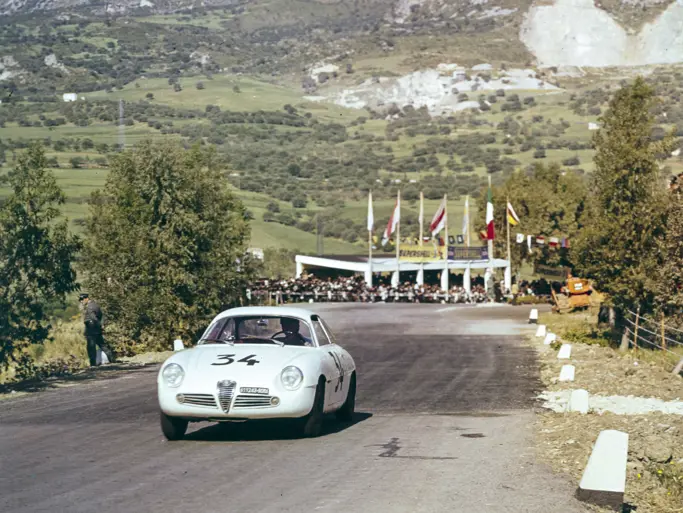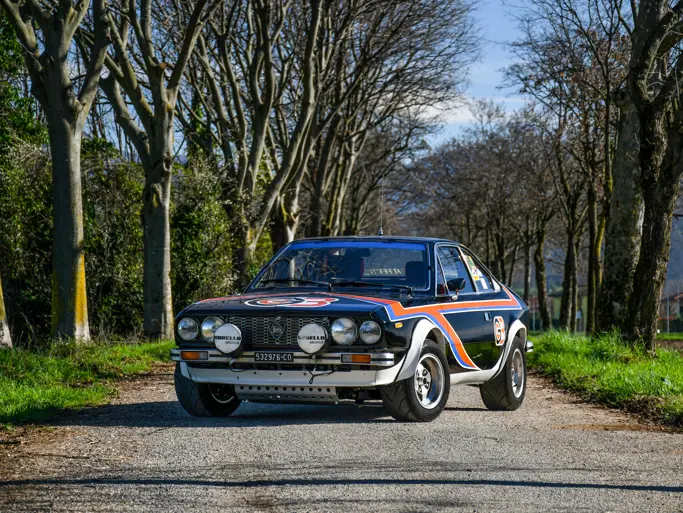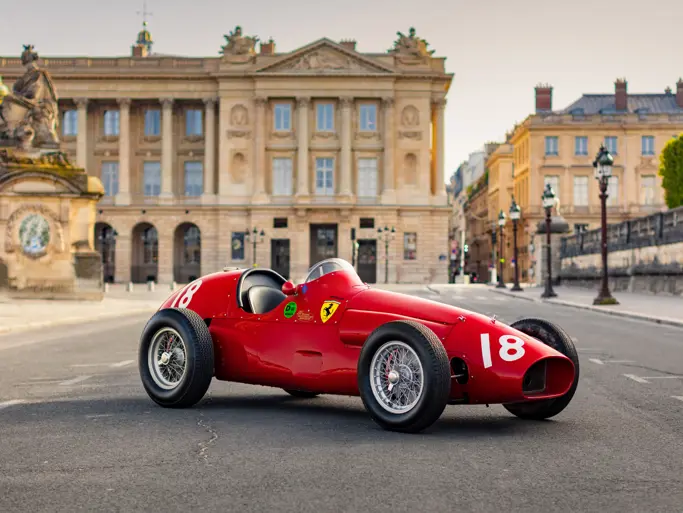Monterey 2022
1998 Ferrari F300 ◊
{{lr.item.text}}
$6,220,000 USD | Sold
 | Monterey, California
| Monterey, California
{{internetCurrentBid}}
{{internetTimeLeft}}

- The most successful undefeated Ferrari Formula One chassis across all eras
- A remarkably preserved, original, and undefeated Scuderia Ferrari example
- Driven to four victories by seven-time Formula One World Champion Michael Schumacher
- The only Ferrari Formula One chassis to run at least three races and achieve victory in every single race entered
- Acquired by the previous owner directly from Scuderia Ferrari in late 1999
- An especially unrepeatable opportunity destined for one of the world's best collections
- The future owner of the Ferrari F300 will be offered an exclusive visit of the ICM Paris Brain Institute and the Richard Mille Swiss watchmaking facilities in Les Breuleux, Switzerland
| 1998 Formula One World Championship Results, | ||||
|---|---|---|---|---|
| #3 Michael Schumacher for Scuderia Ferrari | ||||
| Model F300, Chassis No. 187 | ||||
| Date | Race | Track | Starting Position | Result |
| 7 June | Canadian Grand Prix | Circuit Gilles Villeneuve | 3rd | 1st |
| 28 June | French Grand Prix | Circuit de Nevers Magny-Cours | 2nd | 1st |
| 12 July | British Grand Prix | Silverstone Circuit | 2nd | 1st |
| 13 September | Italian Grand Prix | Autodromo Nazionale Monza | Pole | 1st |
RETURN TO DOMINANCE
The 1998 season saw Ferrari take the penultimate step towards its re-ascendancy in Formula One racing. In the years since its last Constructors’ Championship of 1979 and its last Drivers’ Championship of 1982, the Scuderia had at first struggled, then increasingly dedicated itself to re-establishing its onetime dominance in the sport. Key to this pursuit, of course, was hiring back-to-back championship driver Michael Schumacher away from Benetton in 1996. Schumacher would go on to take the Scuderia to unprecedented heights in the 2000s with a run of six consecutive winning seasons.
In Schumacher’s initial years with Ferrari, the car itself still required some development to contend with rivals such as Williams and McLaren. Seeking to address these deficiencies, in 1997, Ferrari lured designer Rory Byrne out of retirement to replace the departed John Barnard. Though Byrne initially worked to develop Barnard’s 1996 F310 into the F310B for the 1997 season, rule changes following the season’s conclusion mandated an all-new car for 1998.
THE SCUDERIA FERRARI F300
On 7 January 1998, Ferrari invited over 800 journalists to Maranello to preview its new car, which was dubbed the F300. Michael Schumacher, co-driver Eddie Irvine, Ferrari President Luca di Montezemolo, and Scuderia Manager Jean Todt were all on hand to present the F300, which employed a new engine in the 3.0-liter Tipo 047. This impressive, 800-horsepower, 80-degree V-10 unit featured a max engine speed of 17,500 rpm and comprehensively redesigned engine internals. A novel “periscope” exhaust system assembly designed by Willem Toet routed heat up and away from the F300’s seven-speed sequential gearbox; fresh air was similarly introduced through sidepod-mounted intakes and the aforementioned tower above the driver’s head. Another benefit to this design was the tighter “nesting” of the exhaust components, which allowed an overall smaller chassis blueprint rear of the cockpit.
In designing the F300, Rory Byrne had to contend with significant rule changes which greatly impacted the prevailing aerodynamic solutions for Formula One car design. Chief amongst these was the shortening of the car’s maximum width by nearly seven inches, the exclusion of racing slicks in favor of grooved tires, and a host of new rules regulating the construction and size of brake systems.
Byrne’s resulting design featured several developmental alterations to the aerodynamics of the previous F310B, including more sculpted air intake panels that commenced several inches closer to the front of the car. Vertically mounted front shock absorbers made a notable return to the Scuderia’s entry, and independent torsion bar setups with push-rod accompaniment were fitted at each corner of the F300, along with high-carbon composite brake discs and 13-inch Bridgestone alloy wheels.
The F300 would see continued development and fine-tuning during the course of the 1998 season. However, there can be absolutely no doubt among racing historians that the design’s efficient aerodynamics and well-balanced V-10 powerplant were the true foundation of the Scuderia’s incoming millennial domination of the Formula One world.
UNDEFEATED WITH SCHUMACHER; CHASSIS 187
Chassis number 187 is believed to have been completed at Maranello sometime in early 1998 and is the seventh of just nine total F300 examples built for that year’s Formula One World Championship season. Rather importantly, it is the most successful of three race-winning F300 examples used by the team, and also the only F300 to have a perfect race record—winning all four of the Grands Prix it contested in the hands of Michael Schumacher.
Correspondence with Ferrari’s Corsa Clienti Department have revealed the Scuderia’s records for this important, undefeated chassis. Though McLaren won the first two races of 1998, Ferrari bounced back with new Goodyear tires and some tweaks to the car to take the season’s third race at Argentina. A close competition ensued for the remainder of the season, thanks especially to the mid-season developments fitted to chassis 187.
Chassis 187’s first official Grand Prix attendance came during the Monaco race weekend (23–24, May 1998), where it was brought along as the spare chassis, or “T-car,” but was unused. The subsequent Canadian Grand Prix at Montreal’s Circuit de Gilles Villeneuve saw chassis 187 assigned to Schumacher for the first time. Having qualified 3rd, Schumacher started the race behind the pair of McLaren-Mercedes MP4/13s driven by David Coulthard and Mika Häkkinen. This Grand Prix proved to be one of attrition. Following two restarts and three additional safety car periods, which saw 12 of the field’s 22 entries retire prematurely, Schumacher and 187 claimed victory (and fastest lap) with a massive 16-second lead off the runner-up Benetton of Giancarlo Fisichella. The F300’s blistering pace was helped by Ferrari’s brilliant pit strategy, and this eventful race became the first of 187’s four race victories with Schumacher.
The pair continued their successful relationship at the next two races in France and Britain. The French Grand Prix, held at the Circuit de Nevers Magny-Cours on 28 June, saw our subject lot starting from 2nd position on the grid, Schumacher having just narrowly split his McLaren-Mercedes rivals in a tight qualifying session. Schumacher and teammate Eddie Irvine got out an early 1-2 lead above the field, which remained intact until the checkered flag despite a very strong push from Häkkinen, who finished 3rd. Amazingly, 187 carried Schumacher to the finish line a full 19 seconds before Irvine.
During the British Grand Prix on 12 July, Schumacher once again proved the second-best qualifier come race time. But poor weather—the great equalizer—brought intermittent rain and retirements in equal measure. Schumacher responded to a late safety car period which put him within striking distance of the 1st-place Häkkinen by pushing the pace. An alarmed Häkkinen, in his attempt to keep his gap above the incoming Schumacher, evidently took his MP4/13 past its limit, spinning out on the still-wet track and ceding victory to this F300 and the incredible tactician seated in its cockpit. With these three consecutive, and crucial, victories, Scuderia Ferrari vaulted back up the standings and into serious contention against McLaren-Mercedes for both the Drivers’ and Constructors’ titles.
ITALIAN GRAND PRIX AND REST OF SEASON
During 187’s brief sabbatical from race use, Schumacher scored yet another victory in F300 chassis 188 at the Hungarian Grand Prix on 16 August 1998. Earlier results from the interceding Austrian and German Grand Prixes also included important, points-producing 3rd and 5th place finishes, respectively.
Fresh off a heated and controversial DNF result at the rain-soaked Belgian Grand Prix two weeks previous, Schumacher entered the subsequent Italian Grand Prix on 13 September just seven points behind Häkkinen for 1998 Drivers’ Championship. He qualified on pole, and promptly spoiled that privilege by stalling chassis 187 at the start. Building up from a mid-pack position, Schumacher battled up past Irvine and Jacques Villeneuve into 2nd behind Häkkinen. Just like their combat at the British Grand Prix two months prior, Schumacher pushed from behind the “Flying Finn,” forcing him to make a strategic error. On Lap 35, Häkkinen pitted for new tires (excessively worn trying to maintain a gap against 187’s fresher set), and Schumacher grabbed the lead during this 9.7-second intermission. Shortly thereafter, Irvine also passed Häkkinen, and moved up into 2nd place.
As Schumacher urged 187 across the finish line in front of the Monza grandstand packed with legions of rosso-clad tifosi, commentator Murray Walker famously commented, “…the World Championship gap was seven points; Michael Schumacher has obliterated it. It’s even-steven.” With this victory at the Italian Grand Prix, Schumacher achieved his 33rd Formula One victory and tied Häkkinen at 80 points for the Drivers’ title. The Constructors’ title was similarly drawn back into reach by this 1-2 finish, with Scuderia Ferrari now just 10 points shy of McLaren-Mercedes in that respect.
Despite Schumacher’s admirable four-win stand with this remarkably dialed-in F300, a DNF during the season’s last race at Suzuka on 1 November 1998 (in chassis 189) resulted in Ferrari just narrowly finishing 2nd to McLaren in both the Drivers’ and Constructors’ Championships. However, the team’s six victories (Argentina, Canada, France, Great Britain, Hungary, and Italy) and resulting 133 points were still record-breaking performances to that point in the long, illustrious history of the Scuderia. Later in the season, chassis 187 was brought along to the Grand Prix weekends at Luxembourg and Suzuka, but Ferrari reports that it remained unused during those events.
Despite the seeming setback suffered in 1998, the lessons learned propelled the Scuderia to the Constructors’ Championship the following season in 1999, thereby beginning its historic run of consecutive winning seasons, with Schumacher only losing the Drivers’ title because of a broken leg that forced him to miss several races. His return in 2000 marked the beginning of five consecutive Drivers’ Championships and the continuation of Ferrari’s still-unequalled run of six consecutive Constructors’ Championships.
CHASSIS 187 SINCE 1998
The Scuderia retained chassis 187 until September 1999, when it was sold directly, and privately, to the previous owner (along with a small package of spares) in the same race-used condition in which it remains today. In their 23 years of custodianship, chassis 187 has been treated as a closely held and entirely preserved specimen of Formula One history. It has remained shielded from the public during this time, has never been restored or altered from its as-raced condition, and is now publicly offered for sale (and viewing) for the first time in its history.
Eminently rare and forever tied to one of racing’s all-time greatest legends, the extraordinary Michael Schumacher, 187 is without a doubt one of the most significant Ferrari F1 cars extant, being the only undefeated chassis to run at least three races. It offers long-term appreciation as the immediate antecedent of one of Formula One racing’s greatest championship runs, and it can also be enjoyed firsthand as a breathtaking demonstration of the amazing technical specifications and unbridled power of a genuine late-1990s Ferrari F1 car.
The future owner of the Ferrari F300 will be offered an exclusive visit of the ICM Paris Brain Institute and the Richard Mille Swiss watchmaking facilities in Les Breuleux, Switzerland.

